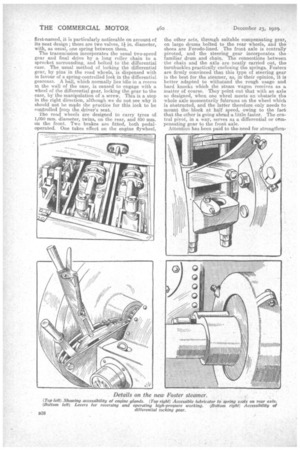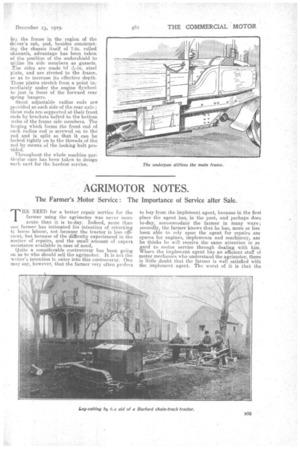A NEW FOSTER STEAM WAGON.
Page 15

Page 16

Page 17

If you've noticed an error in this article please click here to report it so we can fix it.
A New Model on Conventional Lines by an Old-established Company.
THE MAKING OF steam wagons is by no means a new departure for William Foster and Co., Ltd.' as we need not tell those of our readers who have been in touch with the industry for some time. The press of other work, however, in pre-war clays had already compelled abandonment of this class of construction, for a time at least, and when the war came even more important tasks fell to the lot of this active
and progressive company, thus placing the steam wagon entirely out of bounds for the time being. Sir William Tritton may, no do rtbt, tell you (that they made Tanks and, of course, he ought to know, at any rate, whatever it was they did make during the war, it was not steam wagons. However, the war being over, and the factory having to some extent benefited as regards the efficiency of its organization by the way in which it met the extreme reed for speeding up its output, it is eow apparently possible to firid room ty spare for an extension of pro
:A-airtime' and the extension has taken the welcomelorm of recom,.
meneing the manufacture Of steam wagons. The first example of the new model was on view at the recent Smithfield Show. There is subject for wonder in this matter, too, and Cause for speculation as regards the size of the works, having in mind the dimensions of the showman's engine which was also on view at Smithfield, coupled with the knowledge that it was only one of a baker's dozen which were going through the shops. Mass-production crops out in the most unexpected places sometimes, or should we term it massive production ? However, to return to the object of onr present interest.
A cursory glance is sufficient to show that oldestablished principles form the basis of the design. Of striking innovations there is none. The model is the overtype, with a compound engine, 4 ins. and 01 ins, bore by 7 ins: stroke, using steam at 200 lb. initial pressure. It probably develops from 25 h.p. to 30 h.p. in, circumstances of ordinary use, and this, of course, can be increased by 75 per cent., tot emergencies by the usual method of temporarily converting the 1.p, cylinder to use with h.p. steam direct from the boiler. This practice is, of course, not permissible for more than short periods, as the experienced user of steam wagons will realize without any telling.
Viewing the engine from the foot-plate, one is immediately struck with the appearance of accessibility as regards the engine glands and cylinder covers, and, after a while, it becomes apparent that this is due to the unusual design of the crosshead guides, which aro of the plain fiat slipper type, the usual plan being to have bored guides and cylindrical slippers. The arrangement of the levers for engine control differs only slightly from normal, the departure • from the general run of current practice in* this regard being mainly in respect of the control for the double high-pressure working, the lever for which is placed in the same quadrant as the -reversing lever, where it is conveniently axessib:e.
The boiler, of course, is of the multi-tubular locomotive type, with Belpaire type of firebox. The latter is now becoming almost standard in the construction of locomotive boilers for all purposes. It differs from the older type mainly in respect of the method of staying the roof of the box. Instead of attaching the supports of the root of the box-to a number of girder-like crossbars, the top of the boiler itself over the firebox is fiat, and the two surfaces are coupled together by a number of screwed stays. Besides considerably simplifying the construction of the boiler at this point, it is also claimed that, weight for weight, the Belpaire is the stronger, as compared with the ordinary construction. Additionally,. the steam space of the boiler is increased, resulting in easier steaming capacity and a drier supnly of steam to the engine. Better circulation of the water round the firebox is assured, increas.ing its evaporative capacity, and Ies§ening the liability for scale and deposit to rest at this point. The boiler is, of course, construoted to withstand a working pressure of 200 lb. to the square inch, and is tested hydraulically at :350 lb. per sq. in. The grate area is 2.50 sq. ft., and the heating surface 75 sq. ft. The usual fittings, safety valves, pressure and water gauges, etc., are supplied, and, with regard to the
first-named, it is particularly noticeable on account of its neat design ; there are two valves, l in. diameter, with, as usual, one spring between them.
The transmission incorporates the usual two-speed gear and final drive by a lcvng roller chain to a sprocket surrounding, and bolted to the differential case. The usual method of locking the differential gear, by pins in the road wheels is dispensed with in favour of a spring-controlled lock in the differential gearease. A ball, which normally lies idle in a recess in the wall of the case, is caused to engage with a wheel or the differential gear, locking the sear to the case, by the manipulation of a screw. This is a step in the right direction, although we do not see why it should not be ma,de the practice for this lock to be controlled froai the driver's seat.
The road wheels are designed to carry tyres of1,050 mm. diameter, twins, on the rear, and 850 mm. on the front. Two brakes are fitted, both pedaloperated. One takes effect on the engine flywheel,
the other acts, through suitable compensating gear, on large drums bolted to the rear wheels, and the shoes are Ferodo-lined. The front axle is centrally • pivoted, and the steering gear incorporates the familiar drum and chain. The connections between the chain and the axle are neatly carried out, the turnbuckles practically enclosing the springs. Fosters are firmly convinced that this type of steering gear is the best for the steamer, as, in -their opinion, it is better adapted to withstand the rough usage and hard knocks which the steam wagon receives as a matter of course. They point out that with an axle so designed, when one wheel meets an obstacle -the whole axle momentarily fulcrums on the wheel which is obstructed, and the latter therefore only needs to mount theblock at half speed, owing to the fact that the other is going ahead a little faster. The central pivot, in a way, serves as a differential or campensating gear to the front axle. Attention has been paid to the need for strengthen ing the frame in the region of the driver's cab, and, besides constructing the chassis itself of 7-in, rolled channels, advantage has been taken of the position of the undershield to utilize its side members as gussets. The sides are made .'of A-in. steel plate, and Are riveted to the frame, so as to increase its effective depth. These plates stretch from a point irn mecliately under the engine flywheel to just an front of the forward rear spring hangers.
Stout adjustable radius rods Are provided at each side of the rear axle ; these rods are supported at their front ends by brackets bolted to the bottom webs of the frame side members. The forging which forms the front end of eaeh radius rod is screwed on to the rod and is split se that it can be locked tightly on to the threads of. the rod by means of the locking bolt provided.
Throughont the whole machine particular -care has been taken to design each Dart for the hardest service.


























